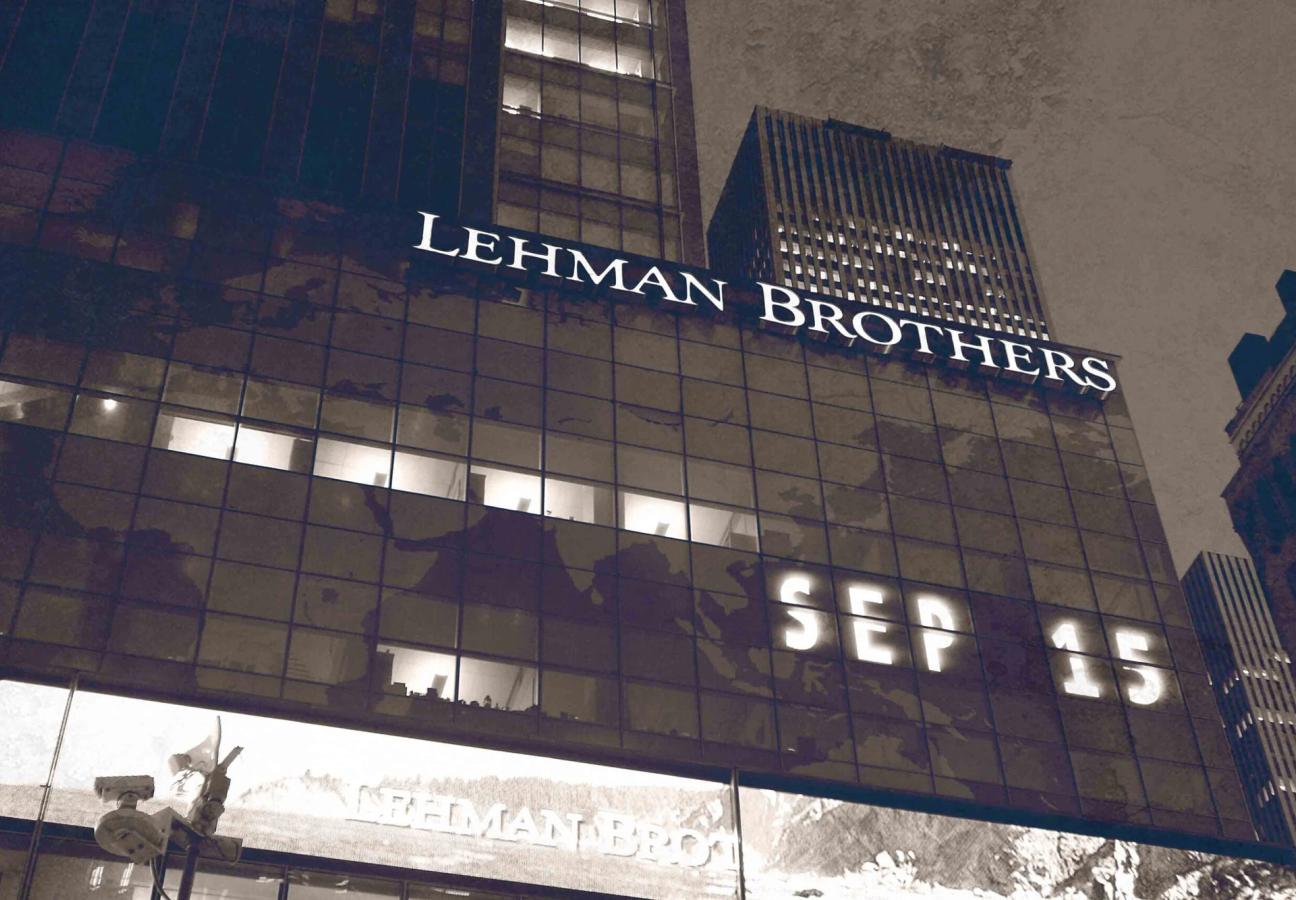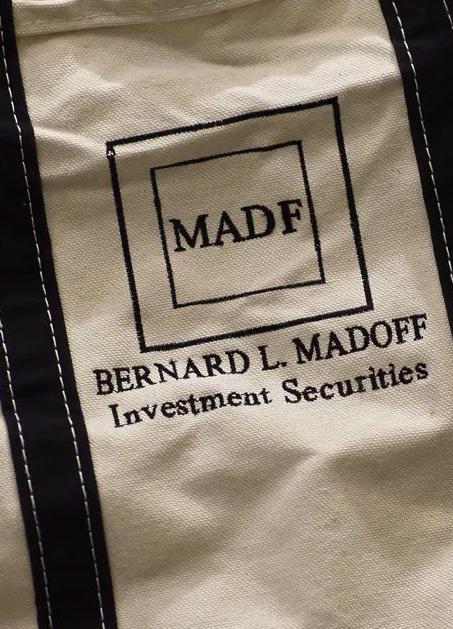
The rise and rise of Financial Crisis Chic
Or how deceased, disgraced institutions have become, somehow, stylish
Words: Harry Shukman
There’s an old clip online of Richard Fuld, the chairman and CEO of Lehman Brothers, explaining to the US government why he earned $500 million during the years he led his company to disaster. It was October 2008 — and watching it now, Fuld reads as a pinstriped, blundering commander of the Light Brigade, charging the planet into the jaws of death, into the mouth of hell. Ignoble 500!
Bankers have long been connoted with cold-blooded animals in the class reptilia, but biologists would have recognised something decidedly herpetological about the way Fuld’s tongue kept darting out of his mouth to moisten his lips and the way he craned his neck up, ready to squirm away from legislative predators before they ate him.
His tongue schlurped out when he was quizzed about his oceanfront home in Florida; his summer vacation pile in Sun Valley, Idaho; his multimillion-dollar art collection; and the fact that the former president of Lehman, Joe Gregory, commuted to work by helicopter. What a comedown for Fuld, whose swaggering presence among the C-suite earned him the nom de guerre “The Gorilla”. It was seven years before he appeared in public again.

This is the type of scene that most readers conjure up when reminded of the names Lehman, Bear Stearns, Bernard L. Madoff Investment Securities — and any other firms that were eaten up in the financial crisis, victims of their own folly. And yet for the young kings and queens of Wall Street and London’s Square Mile, these deceased, disgraced institutions have become, somehow, chic. So much so that old promotional gear – what Brits call ‘stash’ and Americans ‘swag – from these companies currently changes hands for hundreds of pounds.
At the time of writing, and assuming these are all genuine, traders on eBay were flogging Lehman baseball caps (£40), gym bags (£190), fleeces (£76), ring binders (£55), golf shoe bags (£33), keyring torches (£13), pens (£20), coffee pots (£20), beach towels (£281) and leather wine cases (£705).
True Lehman-heads might also enjoy purchasing their 2004 annual report (£63), fixed income product brochures (£45), health and safety policy statements (£13), emergency evacuation packs with goggles and face masks (£70), and if they were so inclined, a letter signed by a former senior vice president named Edward McGlynn from 1982 (£303). There’s also endless offers of expensive kit from Bear Stearns, like an old café swipe card (£28) and a promotional stuffed bear toy (£491).

It would be easy to think that this is exactly what it sounds like, which is junk that even a hoarder would chuck straight in the bin. Should availability always denote value? What would you want, say, with Shakespeare’s old wooden chamberpot, or the rags that Henry VIII used to wipe his arse with? But try telling that to the young financiers bidding for this vainglorious tat.
Mickey Down, co-creator of Industry, the smash hit TV series about the young hires navigating the grad scheme of a ruthless London investment bank, says the appeal of financial crash chic is in recalling a time when it was “actually cool to be a banker”.
“These guys who wear Lehman or Salomon caps probably wish they worked in an era where their job was more of a ‘fuck you pay me’ than a ‘he works in finance, how lame’,” Down tells me. “There’s definitely an element of trolling here as well – why else would you wear Madoff merch?”
“There’s definitely an element of trolling here as well..."
Down is right to ask the question. When the US Marshals auctioned off Bernie Madoff’s possessions back in 2009, customers inexplicably sank a total of $900,000 on his old crap.
One schmuck spent $14,500 on a Mets baseball jacket emblazoned with the Ponzi schemer’s name on the back, and another forked out $1,000 on crummy boogie boards with “MADOFF” scrawled on them in black marker pen. The plastic address sign that sat outside Madoff’s Montauk beach house went for $2,000, and the plastic duck decoys once used to attract birds that he could shoot for sport were sold for $11,500.
As the day traders of the Wall Street Bets Reddit forum like to joke: buy high, sell low.

There is a distinct whiff of nostalgia for these old companies, which exploded long before many of their aficionados were old enough to enter the workforce. They evoke a simpler time of limited regulation and unlimited expenses, guilt-free private jet use and a more liberal ingestion of illicit powders now known as “bathroom extracurriculars”.
Powered by The Wolf of Wall Street and meme accounts like Litquidity, Arbitrage Andy, and Hoeing For Yield —which commemorated the death of Madoff with the words “Rest in Power” — they conjure up a heady picture of finance before the fall. Imagine Dick Fuld living it up in his Florida oceanfront mansion (which sold in May for $32.5m – set over 3.3 acres, it has eight bedrooms, a pool, hot tub, tennis court, and 265 feet of ocean frontage), long before he was hauled in front of a government committee hearing.
This explains the memetic appeal of Patrick Bateman, the homicidal maniac last seen butchering his colleagues in American Psycho. Rowing Blazers, a fancy eclectic Oxbridge-style outfitter, sells a duffel bag emblazoned with the subtle off-white logo of Pierce & Pierce, the company at which Bateman is an investment banker (it costs £120, just like the Duke & Duke bag, the name of the firm in the Eddie Murphy movie, Trading Places).
“For some, it’s a badge of honor,” declares the website. “For others, it’s a token of unearned privilege. But whether you’ve protested Wall Street bailouts or just passed your Series 7, we can all agree that these little bags are so square that they’re hip.”

Jack Carlson, the brand’s founder, adds: “The way people dress today is all about showing off your knowledge, your awareness of cultures and subcultures.” He told the Financial Times that customers go mad for defunct bank merch precisely because of the scarcity and their links to a time when greed was good.
The appeal could also be related to the brash aesthetic that comes on the caps and totes of pre-crash swag, which Down, who is writing season two of Industry, admits he’s a “sucker” for.
“There’s a certain timeless vintage elegance to the logos and artwork of that time – big, bold and brazen – like the kind of people who worked there,” he says. “It feels far removed from the homogenous clean-lines corporate design of everything now, which probably better reflects the droney, algorithmic, cog-in-a-machine nature of the job today.” There’s also something about those handsome serif fonts — embroidered in stark white on green and navy garments — which seem to chime nicely with the nostalgic, 90s, post-divorce-Diana, sports-chic aesthetic that abounds in 2021.
Despite their best efforts, today’s young financiers are probably more machines than masters. Wall Street meme pages are filled with countless photos of unfortunate whizzkids who have been struck by the dreaded “pls fix” email from their bosses on nights out or on holiday. It must have occurred to them that back in the day, when Jordan Belfort wanted to find a dark corner of a club’s VIP area, he probably had funner things in mind than desperately revising a spreadsheet after his fifth Jägerbomb.
They’ve just got to hope that nobody steals their beloved Lehman cap when the MD calls to ask why the hell their algorithm isn’t working.
Want more insight on institutions of the past? Here’s a eulogy for the hotel buffet…
Become a Gentleman’s Journal member. Find out more here.
